You saw a hitting bird with a red head, did you? You can’t help thinking about what it is. That shouldn’t be too difficult to even consider sorting out, would it be advisable for it? What number of sorts of birds with red heads would there be able to perhaps be?
In the United States and Canada there are many birds with either completely or somewhat red heads. Once in a while there is a tad of red. Once in a while the whole bird is for the most part red. Once in a while the red tone is more orange, some of the time it is more pink. The rundown of birds with red heads incorporates these:
- House Finch
- Purple Finch
- Cassin’s Finch
- Red Crossbill
- Pine Grosbeak
- Northern Cardinal
- Pyrrhuloxia
- Summer Tanager
- Western Tanager
- Scarlet Tanager
- Vermilion Flycatcher
- Red-headed Woodpecker
- Red-breasted Sapsucker
- Pileated Woodpecker
- Red-bellied Woodpecker
In the event that you saw this bird with a red head at your terrace feeder, the choices go way down. Indeed, basically 90% of the time you are logical inquisitive with regards to the normal House Finch. Yet, there are different conceivable outcomes. This rundown isn’t every one of the birds with red on the head, yet it is the vast majority of the ones you are probably going to find in your patio. So we should get everything rolling finding what you saw!
Need assistance picking your first pair of bird watching optics?
I did the examination and have chosen 3 low-estimated models to kick you off. These are best for watching birds at feeders just external your windows. They concentrate intently and are reasonable for eyeglass wearers.
Finches with red heads at your seed feeder
Finches love seeds. So they are probably going to appear at your patio seed feeders. Finches are brown smudgy sparrow-like birds, more probable in your trees than on the ground. It is just the grown-up guys that show tone. So in a group of red finches a couple of the birds will show a red head.
There are more than one sort of red headed finch. Truth be told, in the United States there are 3 red headed finches. Finches are like sparrows, so certain individuals inquire as to whether there are red headed sparrows, when getting some information about these birds. As a rule, sparrows will generally benefit starting from the earliest stage finches in trees.
- House Finch: the brown small bird with red head and breast
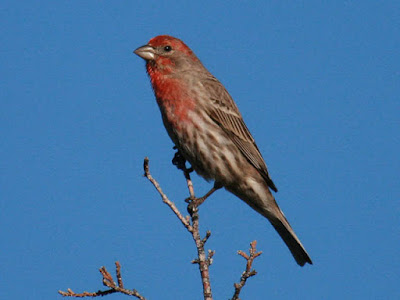
House Finches are found in residential areas, towns, farms throughout the United States. They are only missing from the grasslands of the Great Plains and from most of Florida. They barely reach southern Canada.
They give chirping calls and sing throughout the year with a wiry warble with scratchy notes at the end.
2. Purple Finch

Purple Finches live in damper woods and conifer forests. They are found in summer across southern Canada, barely reaching the northern tier of the United States in the Midwest and New England states.
They are also found in the mountains of the West, clear south to southern California. In winter they move out of Canada and are found throughout the Eastern US.
3. Cassin’s Finch

Males are very softly brushed with pink. The crown of the head is the brightest red. Note a thin white eye ring and deeply forked tail.
As with most finches they eat mostly seeds.
They give a 3-part call “tee-dee-yip” call and have a long song. The song lacks the harsh notes of House Finch and is less structured than Purple Finch.
4. Red Crossbill
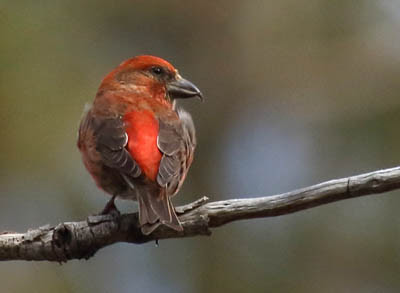
Crossbills sometimes irrupt in winter, moving in huge numbers from one area to another as the cone crops fail or are abundant locally. They may show up at backyard feeders well outside or south of their typical range, but mostly feed on pine cone seeds.
Males are red; females are yellowish. Birds with large crossed bills feed on the seeds of big pine cones. Birds with dainty bills feed on tiny soft spruce cones.
5. Pine Grosbeak

Different forms show quite a bit of variation in the amount of coloring–red on males, yellow on females. Otherwise they are about 9 inches long, plump, with two white wing bars, a heavy black conical bill and forked tail.
They eat seeds, fruit and buds in winter. They are especially fond of the fruit clusters of mountain ash trees.
They sing a warbling song and give a flight call of “pui pui pui.”
6. Cardinals with red heads at your seed feeder – Northern Cardinal
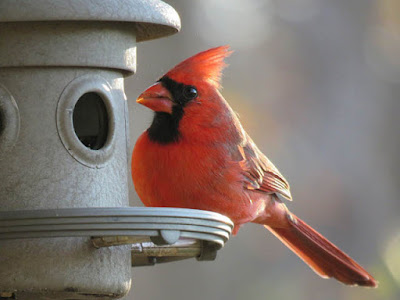
Males are brilliant red throughout with a black face and bib. Females are buffier and duller, but still show some red.
Cardinals eat insects, fruit, and seeds. They readily come to backyard feeders and eat a wide variety of seeds and other bird foods.
Both sexes sing nearly year-round. Common whistled phrases include “cheery cheery cheery.”
7. Pyrrhuloxia

This species is found from Texas to Arizona and south into Mexico. They live in mesquite thickets and other thorny brush.
Pyrrhuloxias feed on the ground and eat weed seeds and other hard seeds.
They sing a liquid whistles song and have a metallic “chink” call.
8. Tanagers with red heads in your shade and fruit trees – Summer Tanager
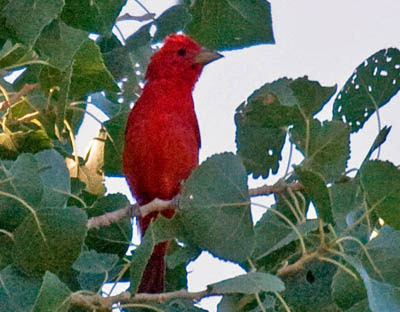
These birds are found in pine-oak woods in the East, but in cottonwoods in the West (see photo above).
They are found in the East from about Virginia to Iowa and south, west from Texas to southern California and into Mexico. They migrate out of the US in winter, except for a few in southern coastal regions from Florida to Texas and southern California.
They sing robin-like phrases and give a “ki-ti-tuk” call.
9. Scarlet Tanager

They summer in deciduous woods in the eastern United States and migrate south out of the country in winter.
They sing hoarse robin-like phrases. Call is “chip-burr.”
10. Western Tanager

They are found in the West, from northern Canada barely to Mexico in summer. They winter in Middle America.
These tanagers may appear in fall at backyard bird feeders. But as with all the tanagers, may be attracted to birdbaths and fountains year-round. They sing a hoarse robin-like song and have clicking calls “pit-er-ick.”
11. Flycatchers with red heads catching flies – Vermilion Flycatcher

Even though they are desert birds they are usually found near stream sides. Typical manmade habitats they favor include golf courses, ball fields, cemeteries.
12. Woodpeckers with red heads on your tree trunks or suet feeder – Red-headed Woodpecker
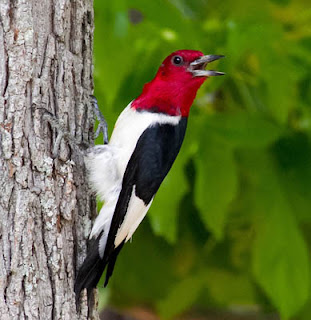
This striking woodpecker is found in most of the East and farms and streamside woods in the Great Plains.
They require trees big enough to drill their nest holes, and away from competition for those holes with European Starlings. They eat flying insects they catch in the air or find other invertebrate prey, nuts, and seeds on the ground.
Their call is a soft rattle.
13. Red-breasted Sapsucker
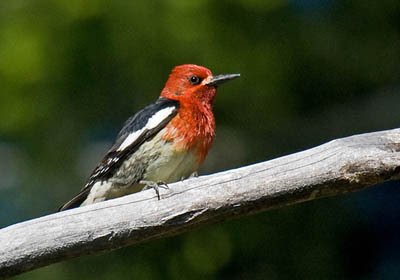
It prefers mixed woods or deciduous trees in conifer woods for nesting. In winter many descend from mountains to lowlands orchards and backyards.
They drill tiny rows of sap wells in trees and then visit them to drink the sap and eat any insects that were trapped in the sticky sap.
They aren’t very active, but give themselves away by their periodic wheezy descending calls.
14. Pileated Woodpecker
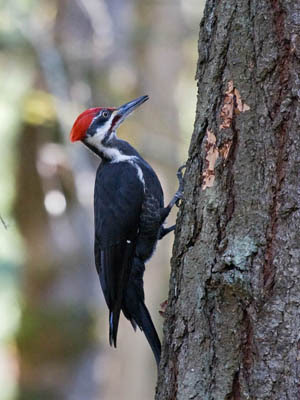
They prefer mature forests and deep woodlands, both deciduous and conifer.
They drill huge square holes in dead stumps and downed trees to excavate carpenter ants for food. They are one of only a few woodpeckers that will drill their nest cavities into firm live trees.
The loud wild call is a sign you are in the wilderness forests, a ringing “kik-kik, kik-kik, kik….”
15. Red-bellied Woodpecker
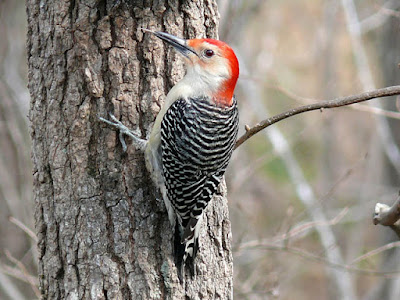
They readily come to backyard bird feeders. They eat suet, peanuts, and sometimes sunflower seeds. Their “wild” food consists of beetles, grasshoppers, and ants.
A common call is a rolling “churr.”
16. Acorn Woodpecker

They are found wherever there are groves of large oak trees, including pine-oak woodlands.
They live in large family groups and small colonies where they collect and store acorns tightly into the bark of trees. As the acorns dry they shrink and may fall out. So they are constantly testing the fit and moving acorns into better-sized holes. Granary trees can contain many thousands of acorns. They eat these acorns in winter. They also eat insects, frequently flying insects they catch in the air.
17. Anna’s Hummingbird
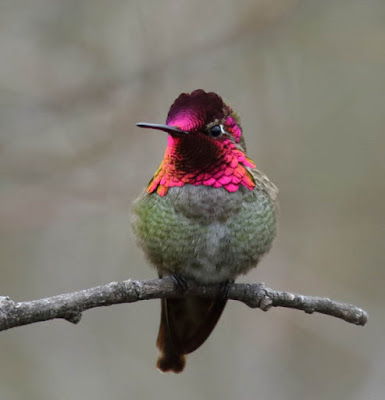
Anna’s Hummingbirds are a common bird of California that have expanded in recent years into Oregon (even a few to SE Alaska) and Arizona. In winter they are found throughout the Baja peninsula and occasionally to Texas.
They eat flower nectar and insects they catch in flight or glean from plants. They take over hummingbird feeders but the tiny Rufous and Allen’s Hummingbirds can sometimes stand up to these larger bullies.

Your article helped me a lot, is there any more related content? Thanks!